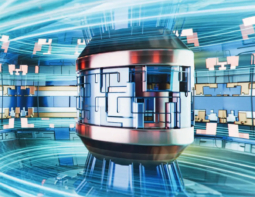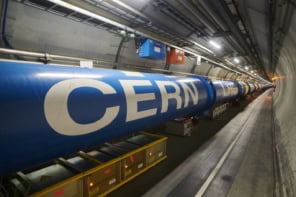
One of the “quietest” magnetic environments in the Milky Way has been unveiled at the Technical University of Munich (TUM). Built by physicists based in Germany, the US and Switzerland, the shielded chamber is claimed to be the most effective for its size, and is able to reduce magnetic fields by a factor of more than one million. It could be used to measure the charge distribution within the neutron and, ultimately, determine whether the particle has an electric dipole moment (EDM). The shield could also be used in biomedical applications such as brain scanning and treating cancer using magnetic nanoparticles.
Lab-based tests of fundamental physical parameters often require the near-total exclusion of electromagnetic disturbances. Some of the main customers of shielding apparatus are those who make high-precision measurements based on a particle’s intrinsic angular momentum, or “spin”, because this is highly influenced by stray magnetic fields. By measuring spin precession – the cycling orientation of spin in an applied magnetic field – researchers can, for example, test whether the neutron has an EDM. The Standard Model of particle physics allows the neutron to have a tiny EDM as a result of the violation of charge–parity (CP) symmetry. However, measuring a larger EDM could point to new physics that explains why there is much more matter than antimatter in the universe.
In 2006 a magnetic shield at the Institut Laue-Langevin in Grenoble, France, reduced external magnetic fields by a factor of about 10,000, allowing for an extraordinary experimental precision that could, in principle, separate two fundamental charges at a distance of less than 10–28 m. That experiment did not reveal any EDM inside the neutron, but it did place an upper limit on the parameter that has yet to be surpassed.
Lots of computation
Improving on this limit is what motivated Peter Fierlinger of the TUM and colleagues to design a better magnetic shield. In principle, creating a magnetic shield is straightforward: a volume simply needs to be surrounded by a magnetizable material, so that any stray magnetic field lines are guided around sensitive instruments, like water flowing around a stone. In practice it is more difficult, requiring Maxwell’s equations of electromagnetism to be solved for a specific material and shape – and this requires a lot of computation.
The team’s shield consists of concentric shells of aluminium and a proprietary, highly magnetizable alloy known as Magnifer. The entire shield occupies a volume of 4.1 m3 and the shielded volume is about 1 m3. It excludes magnetic fields – depending on their frequency – by a factor of roughly one million, which equates to an internal magnetic field of about 0.5 nT (0.5 × 10–9 T). In contrast, the average magnetic field throughout the Milky Way is thought to be about 0.6 nT.
“We are, so far, the first collaboration that has realized such an apparatus with such a small magnetic field, suitable for a hundred times improved measurement,” says Fierlinger, whose group calls the shield the new “state of the art”.
More work to be done
While the team intend to use the shield to measure the neutron’s EDM, not everyone is convinced that it will dramatically improve the result. Werner Heil of Johannes Gutenberg University in Mainz, Germany, says that the shield should not be “overvalued”. “Who benefits from whether the residual field is now less than 0.5 nT or, say, only 1.5 nT?” he asks. “Fundamental-physics experiments such as the search for an EDM of the neutron do not work at such low magnetic fields; instead, one has to apply an additional magnetic holding field inside the shield that is about a factor of 1000 bigger than the residual field. The real challenge is to make the applied magnetic field as homogeneous as possible – and that’s not addressed in the work.”
Whatever the implications for the neutron EDM, the new shield could find applications elsewhere. Magnetic shields are also used in the detection of “biomagnetic” signals from the brain, for instance, as well as in the development of injectable magnetic nanoparticles that target cancerous cells in medicine.
“I am sure some clever people will eventually find other applications,” says Barry Taylor, a scientist at the National Institute of Standards and Technology in the US who helps to set the internationally accepted set of values for the fundamental physical constants. “I am reminded of the two following old saws: ‘Necessity is the mother of invention’ and ‘Build a better mousetrap and the world will beat a path to your door’.”
The shield is described in the Journal of Applied Physics.



